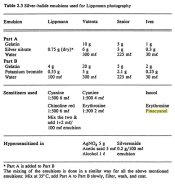Getting down to brass tacks...
Pinacyanol (chloride) = 1,1'-Diethyl-2,2'-carbocyanine chloride [CAS #: 2768-90-3], a.k.a. quinaldine blue
Orthochrome T = 1,1'-Diethyl-6,6'-dimethyl-2,3'cyanine Iodide
Pinaflavol (pinaflavole) = 2-(p-Dimethylaminostyryl)-1-ethylpyridinium Iodide [CAS #: 3785-01-1]
Ethyl Red = 1,1'-Diethyl-2,4'-cyanine Iodide [CAS #: 634-21-9]
Eosin Y = 2',4',5',7'-Tetrabromofluorescein (sodium salt) or 2,4,5,7-Tetrabromo-9-(o-carboxyphenyl)-6-hydroxy-3H-xanthen-3-one Disodium salt (CI# 45380), a.k.a. Acid Red 87
Erythrosine B = 2',4',5',7'-Tetraiodofluorescein (sodium salt) or 9-(o-Carboxyphenyl)-6-hydroxy-2,4,5,7-tetraiodo-3H-xanthen-3-one Disodium salt (CI# 45430), a.k.a. Acid Red 51
Neocyanine = 1,1'-Diethyl-11-(4-quinolyl ethiodide)-4,4'dicarbocyanine Iodide
Kryptocyanine (cryptocyanine) = 1,1'-Diethyl-4,4'-carbocyanine Iodide
Acridine Orange = 3,6-Bis(dimethylamino)acridine Hydrochloride (CI# 46005), a.k.a. Basic Orange 14
Benzopurpurine 4B = 3,3'-[3,3'-Dimethyl-4,4'-biphenylyne-bis(azo)]bis[4-amino-1-naphthalene sulfonic acid] Disodium Salt (CI# 23500), a.k.a. Direct Red 2
Congo Red = 3,3'-[4,4'-Biphenylyne-bis(azo)]bis[4-amino-1-naphthalene sulfonic acid] Disodium salt (CI# 22120), a.k.a. Direct Red 28
The following are all from Ron's list in post #1, but they don't have a colloquial name (if you know one, do share!). Copying here for searchability:
(Peak Absorbance 710nm) = 1,1'Diethyl-2,2'-dicarbocyanine Iodide
(Peak Absorbance 668nm) = 3-Ethyl-2-[5-(3-ethyl-2-benzothiazolinylidene)-1,3-pentadienyl]-benzothiazolium Iodide
(Peak Absorbance 650nm) = 1-Ethyl-2-[3-(1-ethylnaphtho)[1,2d]-thiazolin-2-ylidine)-2-methylpropenyl]naptho[1,2d]-thiazolium Bromide or 4,5,4',5'-Dibenzo-3,3'-diethyl-9-methylthiacarbocyanine Bromide
(Peak Absorbance 522nm) = 1,1'-Diethyl-2,2'-cyanine Iodide [CAS #: 977-96-8], a.k.a. pseudocyanine iodide, pseudoisocyanine iodide
(Other) = 2',7'-Dichlorofluorescein or 9.(o-Carboxyphenyl)-2,7-dichloro-6-hydroxy-3H-xanthen-3-one Disodium Salt
(Other) = 5-(p-Dimethylaminobenzylidene) rhodanine [CAS# 536-17-4], EK catalog says rhodamine, but the internet would suggest otherwise...
I'm thinking that in addition to sensitizers, we've got a great list of baby names here...















